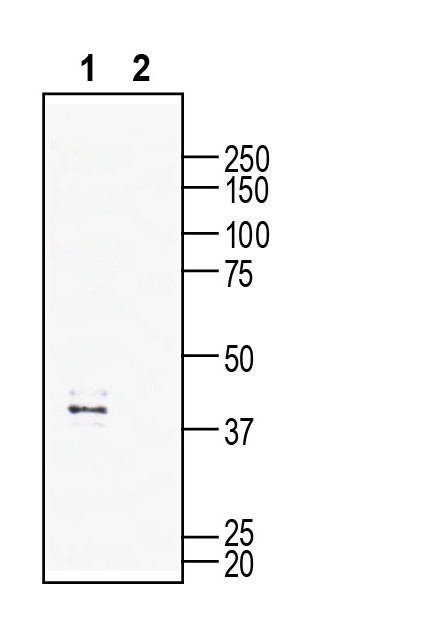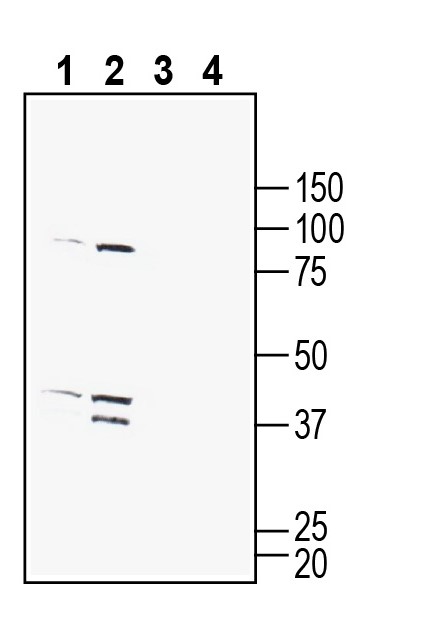Overview
- Peptide CFEPLRMNSKIAGYH, corresponding to amino acid residues 184 - 198 of mouse GPR132 (Accession Q9Z282). Extracellular, 2nd loop.
 Western blot analysis of rat dorsal root ganglia lysate:1. Anti-GPR132 (extracellular) Antibody (#AGR-036), (1:200).
Western blot analysis of rat dorsal root ganglia lysate:1. Anti-GPR132 (extracellular) Antibody (#AGR-036), (1:200).
2. Anti-GPR132 (extracellular) Antibody, preincubated with GPR132 (extracellular) Blocking Peptide (BLP-GR036). Western blot analysis of mouse brain membranes (lanes 1 and 3) and rat brain membranes (lanes 2 and 4):1-2. Anti-GPR132 (extracellular) Antibody (#AGR-036), (1:200).
Western blot analysis of mouse brain membranes (lanes 1 and 3) and rat brain membranes (lanes 2 and 4):1-2. Anti-GPR132 (extracellular) Antibody (#AGR-036), (1:200).
3-4. Anti-GPR132 (extracellular) Antibody, preincubated with GPR132 (extracellular) Blocking Peptide (BLP-GR036). Western blot analysis of mouse BV-2 microglia cell line lysate:1. Anti-GPR132 (extracellular) Antibody (#AGR-036), (1:200).
Western blot analysis of mouse BV-2 microglia cell line lysate:1. Anti-GPR132 (extracellular) Antibody (#AGR-036), (1:200).
2. Anti-GPR132 (extracellular) Antibody, preincubated with GPR132 (extracellular) Blocking Peptide (BLP-GR036).
G-protein coupled receptor 132, (GPR132, G2A) is classified as a member of the proton sensing G-protein coupled receptor (GPCR) subfamily. Like other members of this subfamily, i.e. GPR4, OGR1 (GPR68), and TDAG8 (GPR65), G2A is expressed on the cell surface membrane and contains seven transmembrane domains, similar to serpentine receptors. GPR132 senses changes in extracellular pH, and activation of this proton-sensing receptor by acidosis transduces multiple downstream G protein signaling pathways1.
GPR132 is expressed in a broad range of immunoregulatory cell types, including macrophages, dendritic cells, neutrophils, mast cells, T and B lymphocytes. It mediates immune cell migration as well as phagocytosis and regulates autoimmunity and lymphocyte homeostasis2.
G2A also plays a role in tumor suppression: the tumor microenvironment is acidic due to glycolytic cancer cell metabolism, hypoxia, and deficient blood perfusion and hence, G2A and other proton sensing receptors may be involved in regulation of cancer cell metastasis and proliferation. Small molecule modulators of the pH-sensing GPCRs are being actively developed and evaluated. Research on pH-sensing GPCRs provides important insights into the molecular interaction between the tumor and its acidic microenvironment and may identify new targets for cancer therapy3.
